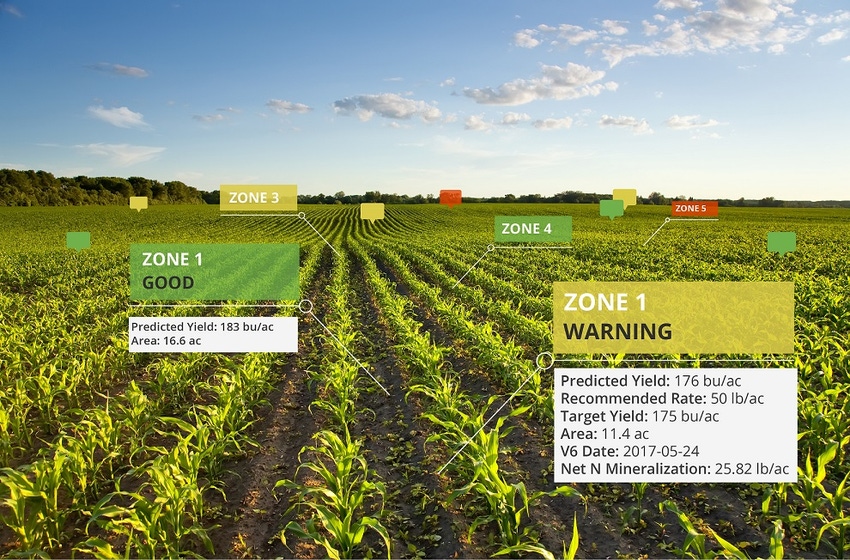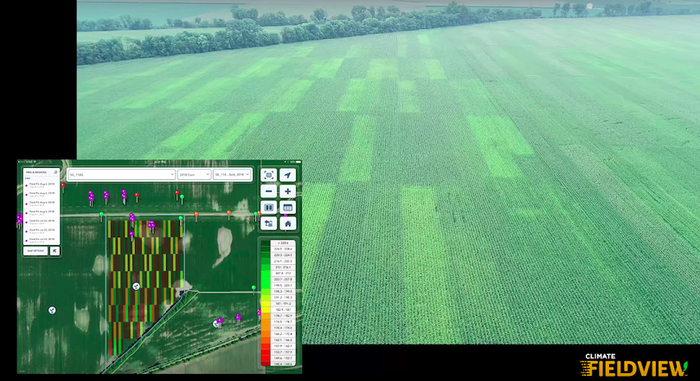December 14, 2018

Think Different
Nitrogen management tools are improving and evolving with use, however they remain just a tool to manage the elusive nutrient.
The impact of using nitrogen tools relates directly to current N use efficiency. The greater the efficiency, the less the impact.
The more localized and accurate the data inputs, the better the recommendation.
When comparing different nitrogen tools, do it over multiple years and under varying conditions.
Use a trusted agronomic advisor who understands your preferred nitrogen tools.
Consider other yield or N uptake limiting factors that could impact nitrogen tool evaluations.
-----------
Nitrogen (N) management is one of agriculture's great enigmas. The once simple formula of one pound of N per bushel of corn has long since bit the dust, but the question remains: How much is enough without being too much?
When it comes to managing N, variability remains supreme, ruled by environmental factors of precipitation, moisture and temperature.
It's no wonder that so many growers have embraced web-based nitrogen management tools in an effort to improve how they use N, even though the tools remain an inexact science.
"I have yet to meet a farmer who isn't trying to be as efficient as possible with inputs," says Ken O'Brien, digital commercial effectiveness manager, Encirca Services, Corteva Agriscience.
"Our premium service, which includes nitrogen monitoring and prescriptions, is in its fifth year, now used on three million acres. To say it is always having an impact on nitrogen use isn't the case. Farmers are already pretty efficient. Where it is helping is sometimes you can get by with a little less or a you need a little more to ensure no impact on yield. Every year is different, and you need to adjust to the weather."
Compare N models
O'Brien points out that if comparing nitrogen tools (or any product) on your own ground, do so over multiple years. "Year to year variability can impact results," he says. "What does the best job in 2019 may not be the best the following year."
Harold van Es, professor of Soil and Water Management at Cornell University, understands the variability of N. He worked with the first nitrogen tool, Adapt-N, from its inception to roll-out in 2008--licensing it to Agronomic Technology Corporation, and now owned by Yara International since 2017. He sees the latest step as important for the future of nitrogen management tools.
"Adapt-N really changed the paradigm of how people approach nitrogen management," says van Es. "It was developed with the help of public dollars at a public institution, but now benefits commercial entities and farmers. Having the technology in the hands of a major company like Yara means the technology can go global."
Van Es stresses that nitrogen tools like Adapt-N find their value as dynamic-adaptive tools. With on-going field monitoring throughout the season, these technologies allow the grower to respond to in-season conditions by adjusting inputs of N.
Weather extremes drive interest
Jamie Denbow, global digital ag lead for Farmers Edge, sees weather extremes continuing to drive interest in nitrogen tools. "We expect the shift to more and more in-season applications to continue," he says. "Instead of putting out a lot up front and then rains don't happen, as was the case in parts of Missouri and Iowa this year, growers can apply as conditions indicate."
Denbow emphasizes the importance of nitrogen tools being field specific, noting that public weather stations spaced 15 to 20 miles apart and generalized SSURGO soil type data are not enough. "We are gathering field-centric weather, soil moisture, crop and planting information to understand how much nitrogen is taken up in each field, every single day," he says.
"We look at soil factors like organic matter and mineralization, as well as bulk density and texture, that control how water flows through the field and how much nitrogen it takes with it. The higher the granularity of the data--and field centric is the highest--the greater the precision."

Right fertility by zone
Denbow cites an example of how the technology was able to identify that a grower was over-applying nitrogen on 30% of the zones in his fields, wasting approximately $21 per acre across 750 acres. "It's not about increasing or decreasing inputs, it's about targeting the right level for every spot in the field."
Brian Lutz, fertility lead, The Climate Corporation, cites grower environmental concerns as another reason for growing interest in nitrogen management tools like Climate FieldView. "Certainly, profit and yield are paramount, but our customers are also concerned about sustainability and maximizing nutrient use efficiency," he says. "There is a big shift on the landscape as growers show enthusiasm for advanced nitrogen management tools and moving application closer to the season, as well as splitting applications in-season."
Another concern among growers, Lutz adds, is that states and regions are moving to N recommendation tools that don't take weather and other factors into account. "If I only use the Ohio State online tool, it doesn't matter whether the field produces 150 or 200 bushels or is high or low in organic matter, the nitrogen recommendation will be the same," he says. "We don't think every field and farm should be treated the same."
More data, improved models
Climate FieldView was one of the first tools to market, and Lutz notes that the company has invested heavily in data collection to improve the model that powers the tool. "We have thousands of acres in nitrogen trials at our five research farms, and data from more than 60 million paid acres enrolled in Climate FieldView in the U.S., Canada, Brazil and Europe," he says. "Through our nitrogen management tools, we've demonstrated an average $12 per acre benefit for growers, and we continue to invest in the tool."
Lutz is confident the models will continue to improve. He points to the use of artificial intelligence (AI) and machine learning from all this data. "One of the biggest constraints in research has been putting out plots and waiting to see the outcome," he says. "With AI, we are able to do things we couldn't before. We can look across our growers and their different conditions and management practices on those 60 million acres. We can learn from that data to provide better and better solutions."
What about the roots?
While the future may produce the ultimate nitrogen tools, the best N prediction currently remains limited to what we know. Meanwhile, what you don't know can be a problem, points out O'Brien. "There are literally hundreds of variables that can impact nitrogen availability and uptake," he says. "If something else is limiting yield, will any nitrogen management tool have an impact? They can tell you how much nitrogen is in the soil, but not if another factor is damaging the root system or preventing uptake. We continue to refine the models to make them better every year, but to say there is zero art left in nitrogen management would be false."
About the Author(s)
You May Also Like




